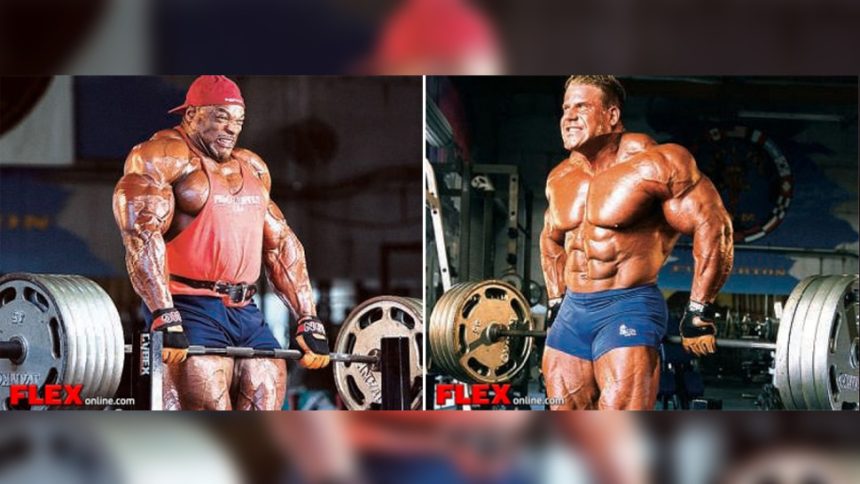A big yoke is a cherry on top of a great physique that you’ll see on strength athletes, bodybuilders, and movie stars. And it makes them look imposing and someone to be feared and admired.
And there are many exercises that will help develop impressive upper traps and back. But not too many exercises that will strengthen your deadlift, grip and build a big yoke all at the same time. Sounds too good to be true?
However, there is one exercise that can do this and more.
Without any further ado, let me introduce you to Kirk Shrugs. The best shrug variation you’re not doing.
How Kirk Shrugs got their name
They got their name from the guy who first used them, Kirk Karwoski.
Kirk is an American world champion powerlifter and 7-time USPF National Powerlifting Champion. And for good measure, he’s a 6-time IPF World Powerlifting Champion and an IPF Junior World Powerlifting Champion.
He’s been strong for a very long time.
He’s considered one best Squatters in the history of powerlifting, and he currently holds the IPF equipped world record in the squat of 1,003 pounds in the 275 pounds weight class, which was set back in 1995.
The story goes he started doing this shrug variation to increase his grip strength for the deadlift. His coach, Marty Gallagher thought this exercise would help him pull heavier.
And Marty was right as Kirk pulled an 800-pound deadlift. But what Marty and Kirk discovered they built a bigger yoke too.
What are Kirk Shrugs?
Kirk shrugs like most shrugs as the train the upper traps, back, and shoulders. But there are a few differences making this exercise more effective than your standard shrug.
How to perform the Kirk Shrug
- Load a barbell at 25 % of your usual barbell shrug weight to start with.
- Grip the barbell using a thumbless grip by hooking the barbell with your fingers.
- “Shrug” the barbell up by using your traps and lats. Pull the barbell as high as you can without using any other part of the body while keeping the shoulder blades back and down.
- Hold the barbell at the navel level for one second. Sounds easy but it isn’t.
- Slowly lower the weight to the starting position, resisting the pull of the weight on the way down. Do this while keeping your shoulder blades back and down.
Also check 12 Best Exercises For Monster Traps
What are they good for?
- They’re very intense and make for a great “finisher” at the end of an upper-body training session. Try for 3 sets of 8-12 reps and the end of a session or choose a weight around 40-50 % 1 RM deadlift and go till failure.
- They strengthen the muscles of the upper back, which are good for posture and play important role in performing deadlifts (keeping the bar close your body) barbell squats ( upper traps to sit the barbell on and to help keep a neutral spine) and improves overall shoulder stability.
- Improving grip strength for all exercises that are grip related such as pull up, chin-ups, row variations, and deadlifts.
- Strengthening the neck area is important for collision athletes such as football, soccer, and boxers as it helps prevent neck injuries and lessen the effects of concussion. (1)
Who should (and shouldn’t) do them?
- Collision athletes looking to strengthen the neck and upper back to stay on the field longer.
- Lifters who looking to strengthen improve their deadlift numbers, pulling and grip strength.
- Bodybuilders looking to improve their symmetry.
- Anybody who wants to look huge.
However, if you have any neck or shoulder issues, then proceed with caution as there is no need to add fire to an already burning flame.
Programming suggestion
Try this tri-set to build a bigger yoke and to improve grip strength.
1A. Barbell bent-over row- Perform strictly and lower the bar with a 3-5 second eccentric. Perform 3 sets to failure, selecting a weight that you can do at least 10 reps with.
1B. Towel Chin up– Hang a towel over a chin-up bar, grip the towel and perform chin-ups as usual. Do 3 sets of max reps going to near failure on each set.
1C. Kirk Shrugs: 3 sets of 8- 12 reps. Use a heavier weight than usual because of the lower reps.
Wrapping up
Although Kirk shrugs only trains a small area of the body, they play an important role for strength and collision athletes. And they help build an impressive yoke that will be the envy of other lifters.
References
- Sports Med.2016 Aug;46(8):1111-24. doi: 10.1007/s40279-016-0490-Neck Muscular Strength, Training, Performance and Sport Injury Risk: A Review. Hrysomallis C1.
- Related Training


